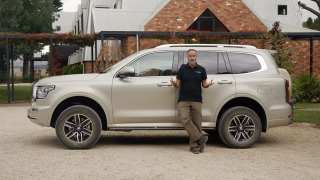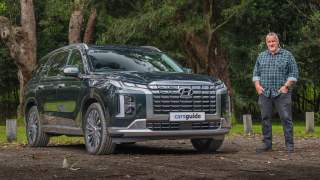
Top tips for using a weighbridge with your car

You might think that overloading your vehicle is only going to add some extra dollars to your fuel bill. However, more serious consequences can result from this common oversight, particularly when heading out on a long trip.
An overloaded vehicle, either on its own or when towing something, is not only illegal but also unsafe, because its handling ability and braking distances can be seriously compromised. It also means that engines, drivetrains, suspensions, axles, brakes, tyres etc are all working harder than they should, resulting in not only premature wear-and-tear but also increased risk of a mechanical failure and at worst an accident.
"No worries," you might say, "my insurance will cover it." Keep in mind that insurance companies don't like paying out claims. So if your insurer can prove that your vehicle was overloaded at the time of an accident, it can reject the claim and leave you seriously out of pocket.
So we hope this has alerted you to the importance of finding out what your vehicle's weight limits are as specified by the manufacturer, at least in relation to its maximum allowable weight when fully loaded (Gross Vehicle Mass) and how much weight it can legally tow (Gross Combination Mass).
The easiest way to measure these weights and others is by using your nearest public weighbridge. Think of these giant scales as your vehicle's best friend, because for a moderate fee ($20-$30 as a rough guide) you can quickly and easily work out if you're running legal or not.
Public-access weighbridges can be found in all sorts of locations, from dedicated weighbridge-only sites to transport companies, recycling depots, landscaping suppliers, local council depots and even large motorway-type petrol stations, to name a few. And their designs can vary from the traditional single deck with an operator on-site to those featuring multiple inline decks with self-serve 24/7 access and automated credit card payment.
To find your closest licensed public weighbridge (there's more than 250 across Australia) the Australian Government's National Measurement Institute website has a free full listing.
Here's a few examples of how handy and versatile a public weighbridge can be for vehicle owners.
For ease of description, think of weight and mass as the same thing. More detailed explanations of the various weight categories can also be found here.
How to measure Tare Mass, Kerb Mass and Gross Vehicle Mass (GVM)
Tare Mass (weight of an empty standard vehicle), Kerb Mass (weight of an empty standard vehicle with a full fuel tank) and Gross Vehicle Mass (maximum weight allowed when fully loaded) are the easiest to measure. Just drive your vehicle onto the weighbridge, stop when all wheels are on the same deck and record the weight. If towing a trailer/caravan, keep in mind the Tow Ball Download (TBD) must be included in the tow vehicle’s GVM (see separate TBD heading).
How to measure Gross Vehicle Axle Mass
The individual maximum weight allowed for front and rear axles. For a single deck weighbridge, drive onto the deck and stop when only the front wheels are on the scale and record the weight. Then drive forward until only the rear wheels are remaining on the scale and record the weight.
Multi-deck weighbridges can make this easier, as you can stop with your vehicle straddling two decks and record the front and rear axle weights at the same time.
How to measure Tare Trailer Mass (TARE) and Gross Trailer Mass (GTM)
Tare Trailer Mass (weight of an empty trailer/caravan) and Gross Trailer Mass (maximum axle weight allowed for trailer/caravan). Tow you trailer/caravan onto the weighbridge, wind down the jockey wheel to support it and then disconnect it from your tow vehicle. Ensure that the jockey wheel is on the same deck as the trailer/caravan and that the tow vehicle is clear of the same deck, then record the trailer weight.
How to measure Tow Bar Download (TBD)
This is the amount of vertical weight your trailer/caravan is exerting on your tow bar. Firstly position the tow vehicle (connected to its trailer but with all of its wheels on a separate deck to the trailer wheels) and record the weight of the tow vehicle. Then disconnect the trailer and record the weight of the tow vehicle alone. The difference between those two weights is the Tow Bar Download.
Typically the TBD should be around 10-15 percent of the Gross Trailer Mass (GTM), which for peace of mind can also be calculated using the GTM and TBD figures as shown here: TBD divided by GTM x 100 = % of GTM.
How to measure Aggregate Trailer Mass (ATM)
This is the Gross Trailer Mass (GTM) plus the Tow Bar Download (TBD). In other words, the maximum towing weight allowed for the trailer/caravan. Tow your trailer/caravan onto the weighbridge, wind down the jockey wheel to support it and then disconnect it from your tow vehicle. Ensure that the jockey wheel is on the same deck as the trailer/caravan and that the tow vehicle is clear of the same deck, then record the trailer weight (GTM). Then just add the TBD to the GTM to determine the ATM. Don’t ya just love all these acronyms!
How to measure Gross Combination Mass (GCM)
This is the maximum weight allowed for your tow vehicle and trailer/caravan combined. This is measured by positioning the connected tow vehicle and trailer on the same deck and recording the weight. If the tow vehicle and trailer are straddling two decks on a multi-deck weighbridge, simply combine the two weights.










Comments